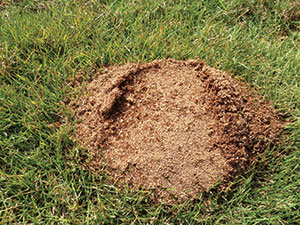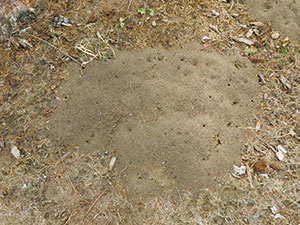The walking dread on golf courses: Red Imported Fire Ants
With the Red Imported Fire Ant, danger lurks behind every massive mound
Flesh-eating zombies are all the rage on TV. On the golf course, fire ant bites just cause a rage…and sometimes worse.
There’s no way around it. Fire ants are nasty little critters. Stumble across their path and they’ll try to eat you alive. This pest may sound a bit like a zombie horde, but instead of being the walking dead, they are just a pain superintendents want dead.
 The Red Imported Fire Ant (RIFA) is an invasive pest that is known to be very aggressive. Even their scientific name sounds intimidating — Solenopsis invicta — roughly meaning “accustomed to being unconquerable.” Dr. Stuart Mitchell, D.O., Ph.D., M.P.H, B.C.E., a board-certified physician and entomologist, says that fire ants are now well established from Kentucky, southwest to Texas and east to North Carolina and Florida. “Red Imported Fire ants are a medical threat to people entering their generally large areas of nesting and activity,” Mitchell says.
The Red Imported Fire Ant (RIFA) is an invasive pest that is known to be very aggressive. Even their scientific name sounds intimidating — Solenopsis invicta — roughly meaning “accustomed to being unconquerable.” Dr. Stuart Mitchell, D.O., Ph.D., M.P.H, B.C.E., a board-certified physician and entomologist, says that fire ants are now well established from Kentucky, southwest to Texas and east to North Carolina and Florida. “Red Imported Fire ants are a medical threat to people entering their generally large areas of nesting and activity,” Mitchell says.
A round of golf is not supposed to resemble Indiana Jones’ temple run. Concerns for human health and safety should be low. However courses across the Southern portion of the United States have to deal with fire ant mounds each year. David Hay, CGCS at Indian Wells (Calif.) CC, says he warns golfers about fire ants in communications with members. “Once we get to the end of March, the first of April, that’s just automatically put in — Please be careful for rattlesnakes, fire ants and bees.”
Know your enemies
Like the ants we see in cartoons, carrying picnics away in a single-file line, fire ants live in colonies. According to Mitchell, their nest mounds can be large and numerous.
“Mature colonies can produce 200 eggs per day,” Mitchell says. To feed all of those mouths, the fire ants go foraging out of the mound through side tunnels. “As omnivores, fire ants forage for seeds, roots, stems, buds, fruits, insects, small rodents and tend honeydew producing aphids.”
The mounds that fire ants call home can be large and fire ants can dig tunnels deep into the soil, searching for moisture. Hay has seen mounds almost as big as gopher mounds on his course.
Joe Steinlage, insectide business manager for Bayer’s turf and ornamentals business, discussed fire ants.
“Fire ants works the soil, whereas a pyramid ant actually forms a pyramid and has a single tunnel that goes down below the soil. A fire ant mound has many tunnels extending away from the mound—fire ant mounds are not typically a pyramid shape,” Steinlage says.
The ants access their mounds through several points of entry. Fire ants can build their mounds around greens, bunkers, in the rough, around the bases of trees or even nestled against rocks and other landscaping.
An aggressive fighting force
If the mound is disturbed, the fire ants spring into action against their attacker.
“When a colony is disturbed, large numbers of female worker ants get very aggressive. When attacking, numerous ants all at once plunge their mandibles into the victim’s skin and inflict numerous painful, burning stings. For those who are allergic to fire ant venom, a severe reaction may occur,” Mitchell says.
For the unsuspecting golfer or worker, this can be a rough wakeup call that the ants are in the area.
Imagine this: a golfer sets down a club on the edge of the green. She putts, grabs the club from the green surface and swings it over her shoulder. Next thing she knows, she’s covered in fire ants that have hitched a ride on her grounded club.
Hay says members of his crew watched this scene play out.
“She stuck it on her shoulder and next thing you know, there were ants all over her. So, she stripped down bare naked… it was pretty comical,” he chuckled. Though this scene seems stolen straight from a Saturday morning cartoon, fire ant bites can be a very serious matter.
“In rare cases, anaphylaxis may result,” Mitchell says. “This is a very serious reaction with symptoms that may include dizziness, tongue and breathing tube inflammation, labored breathing, bluing skin, low blood pressure, loss of consciousness and heart failure.”
For Hay, there have been no negative reactions to fire ant bites as of yet. However Tray Maltby, director of grounds at the Reunion Resort near Orlando, has seen a bad reaction on the course.
“We’ve had some experiences where some of our golfers have gotten bitten and it is a problem,” Maltby says. “One guy had a reaction and the whole bottom part of his ankle and calf swelled up.”
The golfer had been standing on the edge of the rough, unaware that he was on a fire ant mound. According to Maltby, there were quickly about 50 ants on his leg. He received medical treatment and recovered. Knowing about the dangers of these pests however, increases the motivation of superintendents to control fire ants.
Controlling the fire (ant)
Control of fire ants comes in many bottles with many different labels attached. Lane Tredway, Ph.D., is a technical representative at Syngenta who works on product development and assisting customers to develop an effective program.
“Fire ants are one of the most unique pests to deal with on the golf course and in landscaping in that they don’t really cause significant injury to the turf, it’s more of a human health concern,” Tredway says. Never the less, Tredway says it’s a problem that turf managers need to be concerned about.
When selecting a method to control fire ants, Tredway says that superintendents typically had to make a choice between the fast-acting control of a treatment applied directly to the mound, or the use of a broadcast bait treatment. While the first option can yield more immediate results, it does not kill off the colony in the long run. The second option takes more time, but controls the mound more effectively.
“What’s changed now with fire ant bait is that we no longer have to make that choice,” Tredway says. “(Advion Fire Ant Bait) is a very flexible product in that it can be applied as an individual mound treatment and very quickly knockdown and kill-off a mound within 48 to 72 hours, but it’s also long-lasting and can be applied as a broadcast bait for control of fire ants up to three months.”
Maltby says he applies Topchoice from Bayer.
“We slide that in during the springtime. We don’t treat the whole entire property because (of cost), but we do all the tees, fairways, around the tees and greens,” he says. Along with Topchoice, he also utilizes FMC’s Talstar XTRA when fighting for control against the fire ants.
Steinlage says that the Bayer product is a preventative approach and he recommends residual control.
“A lot of times with baits, you may feel that you are just chasing the fire ants around. With an individual mound treatment, you may remove the ants from one mound, but you don’t control the mounds you don’t see a few feet away— and you’re not preventing new mounds. Broadcast bait treatments are more likely to control all existing mounds, but they need to be applied four to five times per year,” Steinlage says. Topchoice is marketed to control fire ants for up to 12 months.
“When you think about treating fire ant mounds… you don’t go out and just pour stuff right on top of the mound,” Maltby says. “That just disturbs them, upsets them and puts them into a panic. More what you do is treat the outer circumference of the mound with these baits.”
Tredway echoed this thought.
“I think one of the most important things to realize, especially if someone is treating an active fire ant mound is that the feeding tunnels are actually around the outer periphery of the fire ant mound,” he says.
Hay utilizes a two-pronged method when working to control fire ants at his course.
“We have the Coachella Valley Mosquito Vector Control District which is funded by property taxes and they have gotten into the picture several years ago in trying to treat the imported fire ants,” Hay says. His course signed a contract with them and they come to the course twice a year, utilizing bait to help control the fire ant population.
The second part of his approach involves Arysta LifeScience’s Aloft. “I tried Aloft one year and, as the seed was growing, you could see exactly where the ants were, you could go out and spray it,” Hay says. “It didn’t make any difference if irrigation was on because it got watered in… and we had tremendous success with that.” He adds that after using this approach, fire ant populations were lowered about 50 to 60 percent.
Capture the queen
Just like in a game of chess, the queen is an integral part of winning the game. Once she falls, the troops are lost.
Maltby says the same is true of fire ants.
 “The ants will go out, they’ll find the bait and they’ll take it back to the mound where hopefully the queen gets it,” he says. “Once you knock out the queen, it’s like knocking out the general of the army. The soldiers don’t know what to do. They will eat the bait and it’s poison for them.”
“The ants will go out, they’ll find the bait and they’ll take it back to the mound where hopefully the queen gets it,” he says. “Once you knock out the queen, it’s like knocking out the general of the army. The soldiers don’t know what to do. They will eat the bait and it’s poison for them.”
Getting this pest under control is a major concern for many superintendents in the Southern part of the United States.
However, Hay says that completely getting rid of the pest is unrealistic.
“All you’re going to do is get them under control. You’re not going to eradicate them,” Hay says. Limiting the danger to members of the crew and golfers enjoying the course is the main goal.
As with most dangers in the world, the best thing to do is be prepared. “If you’re in fire ant country, you will likely have fire ants. Plan on having fire ants. Plan accordingly, and make an application to prevent them before they are a problem,” Steinlage says.
Photos: Bayer; Tray Maltby (fire ant mound); David Hay














